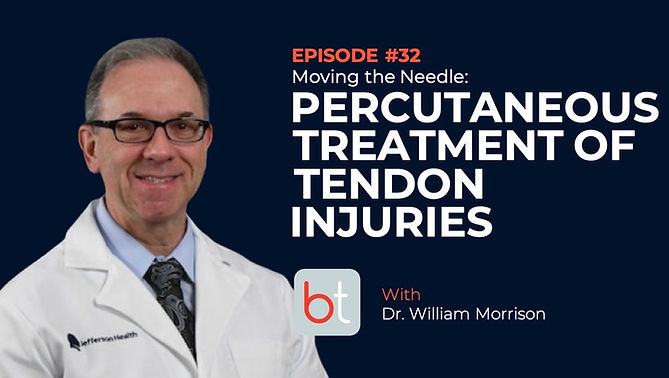BackTable / MSK / Podcast / Episode #32
Moving the Needle: Percutaneous Treatment of Tendon Injuries
with Dr. William Morrison
In this episode, Dr. Jacob Fleming interviews Dr. William Morrison, the medical director of Trace Orthopedics. Trace Orthopedics is developing a minimally invasive implantable device for tendon repairs.
This podcast is supported by:
Be part of the conversation. Put your sponsored messaging on this episode. Learn how.

BackTable, LLC (Producer). (2023, October 4). Ep. 32 – Moving the Needle: Percutaneous Treatment of Tendon Injuries [Audio podcast]. Retrieved from https://www.backtable.com
Stay Up To Date
Follow:
Subscribe:
Sign Up:
Podcast Contributors
Synopsis
William's passion for radiology traces back to his early love for art. In the initial stages of his career, he conceived the idea of a curved, steerable needle to navigate this L5-S1 space for discographies. After bringing the needle to market, its adoption was hampered by cost factors and the challenge clinicians faced in transitioning from traditional straight needles to the new design. Despite the initial challenges and disappointment with the needle's limited uptake, the product found a valuable application in celiac plexus blocks for pancreatic cancer and has shown to reduce surgical risks and complications compared to the traditional approach.
After taking several years off from his innovation journey, William’s personal experience with a partial rotator cuff tear drove him back into action. At that time, the available treatment options were strictly rehabilitation-focused, severely limiting his activity. He crafted a device in his garage using materials from Home Depot to percutaneously anchor tendons. Taking his prototype to Jefferson, where the idea gained endorsement, he proceeded to obtain a patent and established the Trace Orthopedics company. The implanted device has the ability to withstand greater force compared to commonly used suture anchors and is a minimally invasive procedure that is both efficient and single-step. William's invention has garnered interest from various medical specialties. With FDA approval in sight, the device is expected to hit the market within the next year.
During their last remarks, William addresses the persistent challenge of public awareness regarding the full scope of minimally invasive interventional practices within radiology when discussing potential investments. According to William, radiology currently stands at a critical juncture where the significance of imaging and research in driving product development has never been more crucial.
Resources
Trace Orthopedics:
https://www.traceorthopedics.com/
Transcript Preview
[Dr. William Morrison]
I spent a year or two going through rehab. In the meantime, I couldn't do weightlifting. I couldn't golf. I couldn't do things with my shoulders. I was thinking, "This is really terrible. Why can't we just repair these partial-thickness tears?" I was reading that biopsy and thinking, "We can tack these tendons down percutaneously." I developed a device in my garage to do it and tried it out, and it worked really well. I made it out of Home Depot material and the spring in a pen and it worked really well.
Then I figured, "Well, this probably isn't going to work," so I sat on it for five years, and then just more and more cases came through. My mother had gluteus medius tears, and she got muscle atrophy, and now she has difficulty getting around, and I'm thinking, "I got to do something about this because there's a real need for it." There are also reimbursement codes, so it's not like it's going to be a problem in terms of the financial part of it and here's a real clinical need for it. It's in my wheelhouse. It's not much different than what we do now with dry needling, tenotomy, PRP, things like that.
Bone cement: Serious adverse events, some with fatal outcome, associated with the use of bone cements for vertebroplasty, kyphoplasty and sacroplasty include myocardial infarction, cardiac arrest, cerebrovascular accident, pulmonary embolism and cardiac embolism. Although it is rare, some adverse events have been known to occur beyond one year post-operatively. Additional risks exist with the use of bone cement. Please see the IFU for a complete list of potential risks.
The Materials available on BackTable are for informational and educational purposes only and are not a substitute for the professional judgment of a healthcare professional in diagnosing and treating patients. The opinions expressed by participants of the BackTable Podcast belong solely to the participants, and do not necessarily reflect the views of BackTable.














